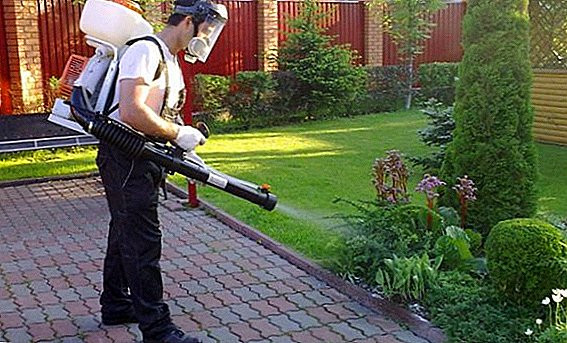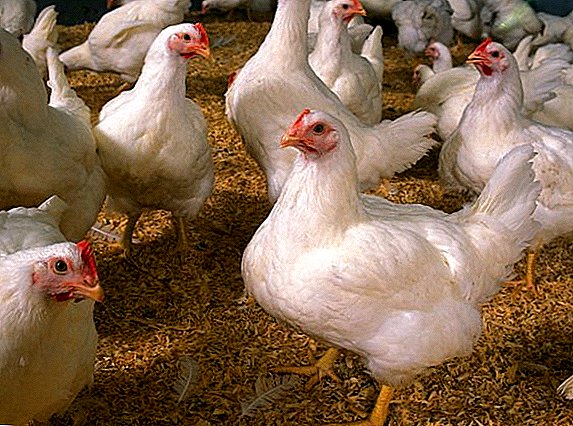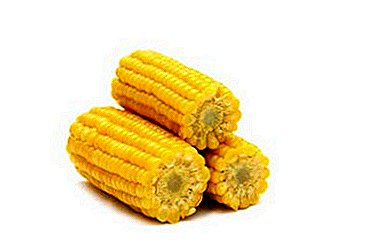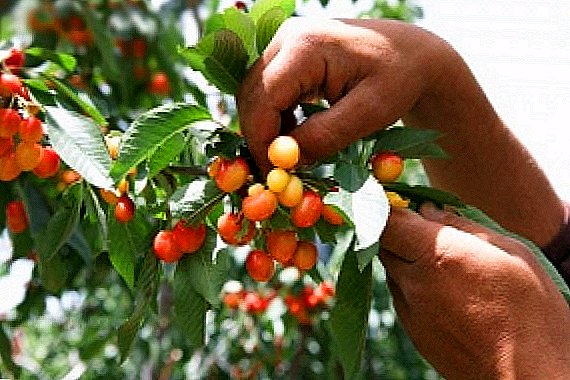
Sweet cherries occupy a special place in the garden of an experienced gardener, and those who decide to plant it for the first time, because the characteristic sweetish taste is so popular with both adults and children.
In order for the quality fruits of the beautiful sweet cherry trees to delight us, we need the right care for the tree.
And this is not only watering and digging, but also timely pruning, which should not harm, but also help to increase the yield and longevity of the plant.
This article pays attention to the most important stage in the care of sweet cherry - pruning. In order not to destroy the trees, you need to have basic knowledge to remove branches and shoots. It would be nice to begin by considering the question of what types of sweet pruning exist.
What you need to know before proceeding to prune cherries
Types of pruning
1) Formative pruning. It is held in the first year of planting cherries and is the very first tree pruning. From the name it is clear that we need to form a skeleton of a tree, a strong base, because it will have the same branches in the crown, as well as create optimal conditions for the ripening of sweet cherry fruits. It is performed in early spring, when the cherry is still in the stage of sleep.
2) Pruning during fruiting - this is a type of pruning, when during the ripening of fruits they get rid of broken, infected and those that densely cover the crown of shoots. Be sure to slow down the growth of the central conductor and skeletal branches, this action is carried out to transfer growth to the weakest side shoots. This is especially true for the higher tier of the crown.

3) Anti-aging pruning - This is a type of pruning, which is carried out when the fruit is damped. To extend the time of fruiting and increase the amount of harvest of berries, it is necessary to shorten the branches of all orders.
Pruning time
When is it better to cut the sweet cherry in spring, summer, or in the fall? If we form the correct crown of a tree, then spring, namely March, before the buds swell, is best suited. After all, when we make a bleed, the tree sap will not flow out, and the wound on the branches will quickly heal.
Sanitary pruning, and this removal of diseased and unnecessary branches is best done in the fall. Freedom from dry, non-fruiting shoots, remove excess weight from the cherry and prepare it for winter.
Trimming is not recommended during the winter months.because the wood at this time of the year is fragile due to the low temperature, and the cuts are of poor quality and nonhealing for a long time.
Some agronomists also perform summer pruning to get rid of the shoots, especially those that grow inside the crown, and from sick and broken branches.
Cropping and crown formation have cherries need to be carried out annually. Its shoots grow very quickly, they need to be restrained in growth, to direct in a certain form. When the cherry starts to please us with fruits, you need to remove the conductor, which is located in the center.
This will slightly stop its growth and translate into lateral branches, which will subsequently provide the potential for the development of new fruit formations. Always remove the branches that go inside the crown, prevent the development of sharp forks.

Trimming scheme
To date, the universal scheme of cherishing is not invented. But common cropping rules We can safely assume control over the growth of the tree and its direction.
In one of the European countries, gardeners invented an interesting method, thanks to which you can easily pick fruits, for example, standing on your feet, without the use of stairs. It is interesting in that the branches of the trees are trying to send in a horizontal rather than a vertical direction, as many are accustomed to, cutting only the tip of the center escape.
Such a pruning scheme is called cupped, that is, pruning is done so that the branches grow at an angle of 45 degrees. Her negative side is that the tree needs to support the branches, since under the weight they can break.
Trimming features
Sweet cherries bear fruit on annual shoots and bouquet branches. The tree is characterized by weak branching and strong growth of shoots at the same time, and it is difficult to form a crown on it.
For the formation of a correct, compact, tree-filled crown to the maximum, they start cutting the tree from the first year of planting.
Pruning is carried out before the beginning of the growing season. When pruning sweet cherries is recommended thin out the crown more, and cut down the length of the branches less.
Branches of sweet cherrythat do not bear fruit, growing at an acute angle are separated with the help of a load or tied to the lower branch, because if this is not done, the branch with sweet cherries can break. And those branches that deviate from the crown, try to pull up to give it a certain shape.

Exhausted growths that are 20 cm in length are young. When pruning, remove 2-year branches. Rejuvenating pruning runs every three to four years. And with the appearance of jerky shoots, they should be immediately removed and transferred to the carrying branches.
Crown formation
Sure to we need to form a crown; if we do not do this, we will get a very high tree with highly rarefied branches. How to harvest with such a sweet cherry?
The best height for it is from 3.5 to 4 m, and the crown should be round or flat-round, this will help to collect a high yield, and care will make it easy. Let's consider what is main types of crowns of cherry trees.
Sparse tier crown. This type of crown formation is considered the best for sweet cherries. Trees of this form have a stem 60–70 cm tall, then the trunk goes, on which the lower tier of the first order branches is located.
These are 3-4 main branches, which are located on different sides of the conductor, and not over each other. The following skeletal branches are located above the first tier in the trunk at 60-80 cm and at a distance of 40-50 cm from each other, and most importantly, they are located not above the lower branches, but in the spaces between them when looking at them from above.
In the first year, when the tree was just planted, it is necessary to measure the height of the trunk, approximately 60-70 cm, then count from 4 to 6 buds (of which skeletal branches will be formed) and cut over the upper bud.
Next spring, from the young shoots that have grown, we will form the first tier of the crown of sweet cherries. To do this, select 3-4 branches, leaving them 50-65 cm in length, the center conductor is cut off at a height of 60-70 cm from the upper branch of the first tier of the crown that we have already formed, while counting 4 buds from which the branches of the first order of the second tier.

In the third year it is important to thin the crown, cut the shoots that are located at an acute angle to the conductor or grow inside the crown. Pay attention that the branches of the second order are not longer than the skeletal branch of the first order, and even better shorter by 10-15 cm, cut them to the desired length. We measure on the central conductor from the second tier to 40-50 cm, count from 4 to 6 buds and cut above the upper bud, they will give us branches of the third tier.
In the fourth year, you need to prevent the central conductor from rising high. To do this, trim the conductor over a weak lateral shoot at 50 cm. The third branches of the sprout branches are 20 cm shorter than the center conductor. All extensions of the skeletal branches should be approximately 70-80 cm, and if they are shorter than this length, then they are not are touching. Do not forget to do sanitary pruning.
For all subsequent years, the task is to control the height of cherries and to do the same pruning as in the fourth year, to ensure that the side branches do not exceed 50 cm.
It is also interesting to read about the features of planting and caring for late sweet cherry.
Flattened crown - considered the most popular among gardeners. After planting a one-year-old seedling in the spring, pruning is carried out at a distance of 70-80 cm from the ground, and in June, a center conductor and two branches, which should grow from opposite sides, are cut off, all excess shoots are cut off.
Next spring, in March, we are looking for the overgrown lower branches to lie at a distance of 40-50 cm, and the main conductor should be higher than the side branches by about 20 cm. In May, we measure 50-60 cm from the lower tier and choose the following two opposite branches. The remaining shoots are deleted. In the third year, when the upper tier of the crown is already formed, it is necessary to trim the key conductor where there is a weak lateral branching.
Bushy crown. Trees of this type are low and convenient for gathering fruits, but they occupy a lot of space in width. After planting the seedling in the spring, it is shortened to 70 cm from the ground. We measure 20 cm from the crown and remove all the kidneys. In June, you need to choose 5-6 strong shoots that grow most evenly, the rest need to be broken off.
Next spring, the grown skeletal branches need to try to give a horizontal position, as well as cut off the edges of the branches of 10-12 buds. In the summer, we follow the removal of second-order branches that grow in the vertical direction.

In the third year, thinning is necessary - we cut off the branches of the second order, which intersect. For the branches of the second, third order and higher in the following years we carry out work, as in the third year, where it is necessary to shorten and thin out.
Time
Pruning sweet cherry in autumn time should pay attention to the fact that it is necessary to form a sparse-tier or cupped crown. Patients infected, broken branches are removed immediately, regardless of the time of year.
Before you start pruning cherries, once again remember all the tips and rules derived from this article, take a look at your tree and proceed, know the correct pruning guarantee of high yield and longevity of your tree.












